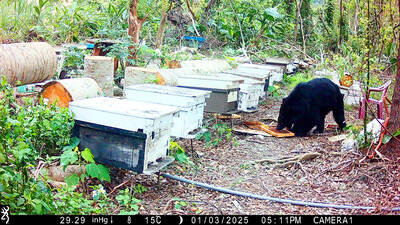The government might face an annual operating loss of NT$200 million (US$6.7 million) if it extends the Taiwan High Speed Rail (THSR) line to Pingtung, in addition to construction costs, an expert from the Society of Railway and National Planning, Taiwan, said yesterday.
Currently, the high-speed rail serves 12 stations and its southern terminus is at Zuoying Station, Kaohsiung. The railway’s train depot is in the city’s Yenchao District (燕巢).
Extending the line from Kaohsiung to Pingtung was one of President Tsai Ing-wen’s (蔡英文) campaign promises during her unsuccessful 2012 presidential run.
Discussions over the project have come back to life this year after the Executive Yuan included a study of the project’s viability in its Forward-looking Infrastructure Development Program budget.
The Bureau of High Speed Rail, which was charged with the feasibility study, has identified two possible routes, one of which would depart from Yenchao and the other from Zuoying Station.
While construction of either is technically viable, both extension lines would lack economic merit, the bureau said, adding that recouping construction costs on an extension within 30 years would be difficult.
The route between Yenchao and Pingtung would stretch about 13.2km and construction costs could top NT$50 billion, the bureau said.
Should the line be built from Zuoying Station instead, it would stretch 17.5km and cost about NT$48.9 billion, it said.
The bureau has estimated that it would take about 10 minutes to travel from Kaohsiung to Pingtung through either route, which is about 20 minutes faster than existing express train services run by the Taiwan Railways Administration (TRA).
However, regardless of the trajectory, it would take 11 years to build a line, taking into account the time needed to plan it, pass an environmental impact assessment, expropriate land and construct it, the bureau said.
Society board director Cheng Yuche (鄭羽哲) said on Facebook that a line starting at Zuoying Station would have a better chance of succeeding.
An extension might see 4,000 to 5,000 daily passengers on weekdays and 4,600 to 5,500 passengers on holidays, Cheng said, citing bureau statistics.
Based on the estimated passenger volume, a high-speed rail system could run 32 train services each day, 16 in each direction, meaning only one departure each hour, Cheng said, adding that operating costs in this scenario would be about NT$365 million, while revenue would only be about NT$128 million.
“The numbers are clear. A high-speed line would lose about NT$200 million each year,” Cheng said. “People wanting to take a high-speed train from Kaohsiung to Pingtung would have only one departure each hour.”
“Even though it would save people 20 minutes on the train, they would still have to travel from a new high-speed rail station to downtown Pingtung,” he added. “Would doing so save people any time?”
The NT$200 million loss does not account for the losses the TRA would incur if it were to lose passengers to the high-speed rail system, Cheng said.
The cheaper and more efficient solution would be to increase bus or the TRA services between Zuoying and Pingtung, Cheng said.
The operating cost of a more intensive bus service would be only 10 percent that of a high-speed rail extension and people would enjoy more convenience at a lower cost, he said.

SHIPS, TRAINS AND AUTOMOBILES: The ministry has announced changes to varied transportation industries taking effect soon, with a number of effects for passengers Beginning next month, the post office is canceling signature upon delivery and written inquiry services for international registered small packets in accordance with the new policy of the Universal Postal Union, the Ministry of Transportation and Communications said yesterday. The new policy does not apply to packets that are to be delivered to China, the ministry said. Senders of international registered small packets would receive a NT$10 rebate on postage if the packets are sent from Jan. 1 to March 31, it added. The ministry said that three other policies are also scheduled to take effect next month. International cruise ship operators

NUMBERS IMBALANCE: More than 4 million Taiwanese have visited China this year, while only about half a million Chinese have visited here Beijing has yet to respond to Taiwan’s requests for negotiation over matters related to the recovery of cross-strait tourism, the Tourism Administration said yesterday. Taiwan’s tourism authority issued the statement after Chinese-language daily the China Times reported yesterday that the government’s policy of banning group tours to China does not stop Taiwanese from visiting the country. As of October, more than 4.2 million had traveled to China this year, exceeding last year. Beijing estimated the number of Taiwanese tourists in China could reach 4.5 million this year. By contrast, only 500,000 Chinese tourists are expected in Taiwan, the report said. The report

HORROR STORIES: One victim recounted not realizing they had been stabbed and seeing people bleeding, while another recalled breaking down in tears after fleeing A man on Friday died after he tried to fight the knife-wielding suspect who went on a stabbing spree near two of Taipei’s busiest metro stations, Taipei Mayor Chiang Wan-an (蔣萬安) said. The 57-year-old man, identified by his family name, Yu (余), encountered the suspect at Exit M7 of Taipei Main Station and immediately tried to stop him, but was fatally wounded and later died, Chiang said, calling the incident “heartbreaking.” Yu’s family would receive at least NT$5 million (US$158,584) in compensation through the Taipei Rapid Transit Corp’s (TRTC) insurance coverage, he said after convening an emergency security response meeting yesterday morning. National

The Forestry and Nature Conservation Agency yesterday launched a gift box to market honey “certified by a Formosan black bear” in appreciation of a beekeeper’s amicable interaction with a honey-thieving bear. Beekeeper Chih Ming-chen (池明鎮) in January inspected his bee farm in Hualien County’s Jhuosi Township (卓溪) and found that more than 20 beehives had been destroyed and many hives were eaten, with bear droppings and paw prints near the destroyed hives, the agency said. Chih returned to the farm to move the remaining beehives away that evening when he encountered a Formosan black bear only 20m away, the agency said. The bear